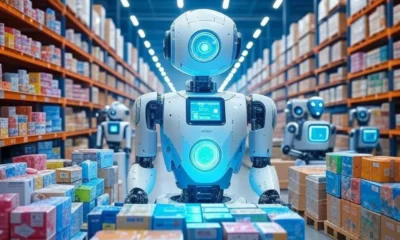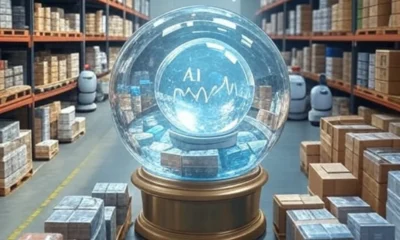Artificial Intelligence
Using AI to Provide Real-Time ETA and Delay Alerts to Customers
Learn how I use AI to improve delivery tracking with real-time ETA updates and delay alerts.
Discover how this tech boosts customer satisfaction and reduces support calls.
Have you ever wanted to be able to know the time your package will reach your door without calling or guessing? That’s where AI for real-time ETA and delay alerts comes in, and honestly, it’s changing everything for me and my business. Today, in the rapidly developing world, customers, such as me, want the latest news, and when we do not get it, it is just overdue.
Definition:
AI-powered real-time ETA systems use smart predictions to deliver accurate arrival times and alerts if there are any delays. It will result in reduced surprises, reduced complaints, and more pleasant experience by all the parties, particularly the one waiting on the other side.
I have witnessed the way this technology makes the satisfaction high, reduces the service calls, and demonstrates confidence with every delivery. In the following paper, I will dissect how it works, and why it is important, and how businesses such as mine can keep up. In case you have ever asked yourself how you can make your customers feel heard, seen, and informed, then read on.
What Is Real-Time ETA and Delay Tracking?
Real-time ETA tracking gives customers like me the power to know exactly when something will arrive without guessing.
It does not base on old checkpoints, but on updated information in transit that gets updated frequently showing what is actually going on in transport. This implies that I no longer find myself stuck in the state of questioning where my order is and when I can have it at my door. Such communication ensures that frustrations remain at minimum and satisfaction is on the maximum level, and that cannot be with less significance in the modern market.
Personally, this technology eliminates the guesswork out of shipments and inserts new information that will help me properly and plan accordingly. It is no longer a tracking number, it is a live experience making me feel to be in control of every single delivery that I anticipate.
How Does AI Calculate Real-Time ETA Accurately?
I had assumed that the ETA updates implied nothing but distance, but AI entirely revolutionized the calculation of these time values.
Currently, AI-based systems can simultaneously use huge amounts of real-time information such as GPS, speed of traffic, weather conditions, and even the availability of roads. These intelligent models include all this information and determine the most correct arrival time in accordance with actual problems.
What is more impressive is that AI receives information to allow future forecasts to be more accurate and reliable based on the past deliveries. In case a driver tends to have delays in some particular road, AI keeps it in mind and avoids it further without any intervention.
Such dynamic routing assists in correcting and updating ETA calculations on a minute-by-minute basis with no human involvement into the system.
AI can continuously manipulate itself with the new data to provide me with an ETA that I can believe and not just a general estimate.
It is similar to having a personal assistant who is following my order and notifying me by text when there is a significant progress during the delivery.
What Does AI Tell Me There is a Delay in Real-Time?
Instead of either hearing about it late, or hearing nothing about it I would simply receive an alert on my phone or inbox in real-time. These alerts are not generic, though–they normally tell me the cause of the delay, and provide me an updated estimated arrival time in the same breath.
Even better is that the delay message, thanks to AI, is personalized to feel informative, helpful, and one that can be trusted. It will not necessarily say something like, your order is late, but will also explain why and what could happen next which makes a big difference.
Such proactive communication makes me calm and informed particularly when I am waiting to receive something urgent.
Also, AI determines how to reach me in the most appropriate manner, either a text message, push, or even by clicking on the chat bot.
What Are the Business Benefits of Real-Time ETA and Alerts?
As a business owner, I’ve seen firsthand how real-time ETA updates and alerts can totally transform the customer experience.
When a customer such as oneself can tell the exact time something will be delivered, he or she is more assured, and has fewer chances of calling a support team. Besides loyalty, this will also eliminate unnecessary communication which consumes both time and energy.
Due to the provision of AI-based information in a timely manner, my enterprise receives less complains but more positive feedback following each delivery. Well, people enjoy the updates that are timely and truthful, and that gives them trust to keep returning every time.
It can also give me an added advantage since customers expect a quick and clear communication with any brand that they are dealing with.
In case of meeting that need and others can not, I instantly become unique and more customers will come back to repeating businesses with me longer.
What are the real-life usage points of an AI-based ETA tracking?
I have observed the massive impacts of an AI-powered ETA tracking system to its industries that deal with speedy, dependable, and transparent deliveries.
In e-commerce scenario, we always anticipate real-time updates on such platforms as Amazon as they have become the gold standard.
With AI, these updates are now accurate, automatic, and thus give me the feeling that I am in control without having to seek assistance.
Supply chain management AI-based technology is applied by third-party logistics providers to organize complicated supply chains including the cooperation of numerous carriers and handoffs of delivery every day.
AI assists in monitoring all those moving parts and notifies everyone on the verge of something going wrong before it becomes a significant problem. It keeps suppliers, truckers and customers in synch even across states or time zones.
What are the Technologies that Achieve the Possibility of AI-Based ETA Tracking?
When I first learned how real-time ETA tracking works, I was surprised by how many technologies come together behind the scenes.
It begins with AI algorithms which continually analyse the patterns of delivery, driving style of delivery operators and traffic within the various regions.
I also use IoT, such as GPS trackers and car monitors sending realtime updates of the location, speed, and other conditions on the road.
These gadgets communicate with the cloud, and they allow the AI device to make quick judgments without requiring a human to solve the issue.
Cloud-based solutions also carry a vital role since they facilitate the exchange of information between drivers, dispatchers, and customers such as me. This combination of hardware, software and AI is what makes the system so genius, speedy and robust to businesses and users.
What are the issues of AI Utilization in ETA and Alerts?
Although I am in love with the capabilities of AI, I also have observed few challenges in attempts to make it work to perfection. Data quality is one major concern without proper or complete data within the system- the predictions may be completely in error. A large percentage of the businesses still run legacy software and combining AI with that can be tedious, time-consuming, and insanely costly.
When the upgrades are not performed in total system occurrences, the upgrades are either late or not delivered to the customer hence spoiling the entire experience.
There is also a question of privacy and security in managing real time information in both cars and tables of customers such as mine.
Companies need to be open and safe with information to keep me at ease with entrusting the company with my detail.
How Can I Get the Best Results from AI-Based ETA and Delay Alerts?
Using AI to track was one of the things that I learned and I know that the best thing to do with this concept is to begin with a small pilot program and grow with time. This can help me by testing the system on a single delivery route or region so I will be able to fix it before implementing it throughout the company. This helps me to evade making huge scale errors and acquire trust in the system, step by step, within my team, and customers.
I also ensure my data sources are constantly synced on real-time basis in order to allow AI to work with most accurate inputs. This is in the form of clean GPS connection, traffic feeds and properly set sensors on all the vehicles we consume on delivery. Once the data is correct, the AI is correct- and my customers receive updates that they trust and need not second guess anything.
The other tip that I adhere to is maintaining the writing of friendly and clear alert messages that make people interpret delays in a manner that is easily comprehensible to them. I do not merely pass along an ETA, I update customers on what is taking place, why it is taking place and when the fix should be coming their way.
Where to Next with AI in Real-Time Shipment Tracking?
I have come to observe that AI has no longer become a tracking technology but it is now moving more to anticipating the things that might go wrong even before they do. New systems are being worked on, which warn me against potential dangers such as missing handoff or late pick up or traffic congestion. That allows me time to rectify my operations or advise customers in advance so that I am ahead of any hitches of the service.
Second interesting trend is the implementation of AI in the use of customer service tools such as chatbots and voice assistants associated with shipping. It makes the whole experience easier both among my team and my customers, and it reveals how intelligent AI is becoming.
In the near future, even this functionality may be provided with AI such as providing recommendations based on my historical delivery information (such as optimal time of day to ship or shipping route). Such customized intelligence would enable my business to minimize the downtime and to streamline the operation of the whole business.
Conclusion: Why Real-Time ETA and Delay Alerts Matter More Than Ever?
For me, using AI to provide real-time ETA updates and delay alerts isn’t just about speed it’s about building trust. It is that type of loyalty that all the businesses, including mine should be targeting in the current highly competitive market.
AI allows me to do more than just tracking the delivery, but turning them into a personal and accurate, and stress-free experience. I can learn about issues early thanks to sharper prediction, early warning and efficient communication to prevent issues before they even occur and to respond quicker in the event that issues still occur. This technology puts me ahead of my competition, saves my time, most importantly- it makes my customers happy with every order they receive.
I have experienced the effects myself and trust me, it is one of the brightest moves you can ever make on behalf of your business. What Do You Think? So would you trust AI to keep you updated? Share your ideas in the comments- and by all means share this with anyone who needs to take their delivery stuff up a notch!
-

 Artificial Intelligence8 months ago
Artificial Intelligence8 months agoHow to Use Grok AI: A Complete Guide
-

 Artificial Intelligence10 months ago
Artificial Intelligence10 months agoWhat is Artificial Intelligence? A Comprehensive Guide for Businesses and Enthusiasts
-

 Artificial Intelligence9 months ago
Artificial Intelligence9 months agoUnlocking the Power of Artificial Intelligence Tools
-

 Artificial Intelligence9 months ago
Artificial Intelligence9 months agoWhat is DeepSeek? Revolutionizing AI with Cutting-Edge Solutions
-

 Artificial Intelligence5 months ago
Artificial Intelligence5 months agoAI Technologies in Warehouse Automation:
-

 Artificial Intelligence5 months ago
Artificial Intelligence5 months agoPredictive Analytics for Demand Forecasting:
-

 Artificial Intelligence6 months ago
Artificial Intelligence6 months agoMeta’s AI Push: The Standalone Assistant App Set to Rival ChatGPT
-

 Artificial Intelligence5 months ago
Artificial Intelligence5 months agoHow Artificial Intelligence is Revolutionizing Logistics:


